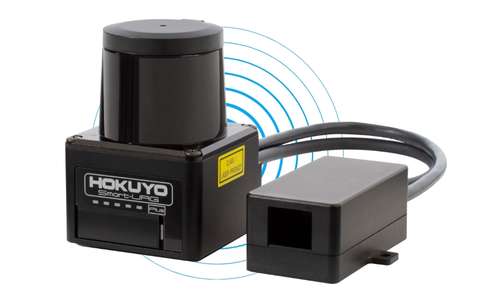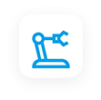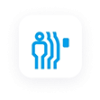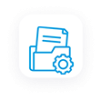Laser distance sensors are at the heart of this precision, offering non-contact, millimeter-level measurement across a wide variety of tasks. Whether you’re aligning robotic arms, positioning crane spans, or guiding AGVs through busy warehouses, accurate distance feedback makes all the difference.
From factory floors to vehicle fleets, industries are leveraging these sensors not just to avoid costly mistakes, but to boost safety, enhance efficiency, and scale operations. In this article, we’ll explore how laser distance sensors work, what specs matter most, and where they make the biggest impact. We’ll also dive into real-world applications - including a look at versatile options like Hokuyo’s PGL Series and UST-30LC—so you can see how laser distance sensors deliver practical benefits in industrial settings.
What Are Laser Distance Sensors?
Laser distance sensors use light to measure distance without physical contact. By emitting a laser pulse and calculating the time it takes to reflect back (time-of-flight), these sensors deliver accurate and repeatable measurements in real time.
Principles of Measurement
- Time-of-Flight (ToF): Measures how long it takes for the laser to return.
- Triangulation: Uses the angle of reflected light for close-range accuracy.
- Phase Shift: Analyzes wavelength shifts for higher precision over mid-range distances.
Key Specs That Matter
- Accuracy: Up to ±3 mm in some models.
- Range: From a few centimeters to 180+ meters.
- Scan Rate: High-frequency outputs (up to 100 Hz) for dynamic environments.
- Environmental Rating: IP65 or higher ensures durability in dust, moisture, or vibration.
Applications in Factory Environments
Quality Inspection & Part Positioning
In electronics or automotive assembly, a single misalignment can halt production. Laser distance sensors measure spacing, depth, and alignment, ensuring each part is placed with precision.
Example: A robotic welder verifies part position before firing, reducing errors and preventing costly rework.
Conveyor & Material Handling
On high-speed lines, products must be perfectly spaced. Laser distance sensors maintain consistent product flow and detect jams before they escalate into downtime.
From Factory Floor to Fleet


Automated Guided Vehicles (AGVs) rely on real-time feedback for navigation. Compact sensors like the UST-10LXB-H02 offer 0.125° angular resolution and 40 Hz scan rates, ensuring AGVs detect pallets, people, or debris before accidents happen.
Cranes & Gantries
Height and span positioning is critical in steel mills, ports, and warehouses. Laser distance sensors monitor lifting height and detect overhead obstacles, preventing dangerous collisions and ensuring compliance.
Designing for Real-World Conditions
Handling Surfaces & Reflectivity
Laser distance sensors must work on shiny steel, dark rubber, and even dusty concrete. High-performance sensors compensate for varying reflectivity to maintain accuracy.
Durability & Ratings
Industrial environments are harsh - excessive dust, high humidity, and vibrations are constant challenges. Models rated IP65 and above thrive in these conditions, ensuring uptime without frequent maintenance.
The Case for the UST-30LC: A Dual-Purpose Solution
Spec Highlights:
- Range: 30 - 60 meters
- Angular Resolution: 0.125°
- Field of View: 270° with 3 output zones
- Multi-Echo Function: Detects through rain, dust, or fog
This versatility makes it equally valuable in fleet navigation and static detection, providing reliable performance in dynamic spaces.
ROI and Operational Benefits
Laser distance sensors offer measurable returns that go beyond simple accuracy. By reducing errors and scrap, they help manufacturers avoid costly rework and wasted materials. At the same time, real-time detection enhances safety by protecting workers and equipment from collisions, while proactive monitoring minimizes downtime and keeps production lines moving.
In mobile robotics, their compact and energy-efficient design lowers power demands, extending operating time and reducing energy costs. Together, these advantages translate into higher productivity, safer workplaces, and a stronger long-term ROI for any operation that integrates laser distance sensors.
Future Trends in Laser Distance Sensors
- Miniaturization: Even smaller sensors without loss of accuracy.
- Integration: Pairing with AI and machine vision for predictive analytics.
- Higher Speed Mapping: Enabling real-time 3D modeling alongside 2D detection.
Quick Takeaways
- Laser distance sensors deliver millimeter-level accuracy across industries.
- Compact models enable AGVs, AMRs, and robots to navigate safely.
- They outperform traditional sensors on reflective or dark surfaces.
- Products like the UST-30LC combine obstacle detection and measurement.
- Investing in durable, IP-rated models ensures long-term ROI.
From the factory floor to logistics fleets, laser distance sensors are transforming industrial automation. They enable safer collaboration between humans and machines, optimize workflows, and protect valuable assets from costly errors.
Whether guiding AGVs through narrow aisles or monitoring cranes in high-risk zones, these sensors offer precision you can count on. As industries push deeper into automation, the need for smarter, more compact, and reliable measurement tools will only grow.
At Hokuyo, we’re committed to engineering sensors that not only meet today’s needs but anticipate tomorrow’s challenges. Explore our portfolio of laser distance sensors and see how they can elevate your operations.

 Factory Automation
Factory Automation Logistics Automation
Logistics Automation Process Automation
Process Automation Crane Collision Avoidance
Crane Collision Avoidance LiDAR/Obstacle Detection
LiDAR/Obstacle Detection Safety Laser Scanners
Safety Laser Scanners Optical Data Transmission
Optical Data Transmission Hot Metal Detectors
Hot Metal Detectors Laser Distance Sensor
Laser Distance Sensor Blog
Blog Whitepapers
Whitepapers Case Studies
Case Studies Infographics
Infographics